
The Woodpeckers
The Picidae – the Woodpeckers – are among the most ancient of all bird families, and also one of the most successful. There are no fewer than 256 species, and they can be found from sea level to high altitudes across every continent except Australasia and Antarctica. None are strong long-distance fliers, so they are largely absent from offshore islands, while most (though not all) are highly sedentary. Sadly, two of the largest and most spectacular species, the Imperial and the closely related Ivory-billed, are almost certainly extinct.
As their names suggest, most members of the Picidae peck wood, but there are exceptions such as the wrynecks, the Ground Woodpecker of Southern Africa, and South America’s terrestrial flickers. The greatest variety of woodpeckers is to be found in South America. Ecuador, for example, has close to 40 species, considerably more than the whole continent of Africa, while Europe has a mere 10, the British Isles just three.
Here, contributors to 10000 Birds describe their favorite species, or those that they are most familiar with. With just 10 species considered, the woodpeckers are a family we are likely to return to (David Tomlinson).
Black Woodpecker (Dyrocopus martius)
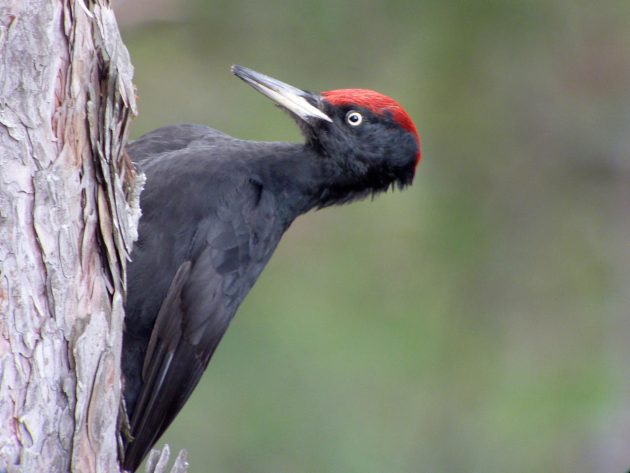
My first Black Woodpecker was a 70mph bird. No, it wasn’t flying at 70mph, but I was driving at this speed on a German autobahn when one flew over the road. I was delighted with my sighting, for this is a bird high on the wanted list of all British birders. It’s a species that has never been recorded in the British Isles, though it can be found just across the Channel in northern France. Woodpeckers don’t like flying over water, so the English Channel is a major barrier.

As big and as black as a rook, but with a flaming red crest, Dyrocopus martius is unmistakable. It’s much the largest of Europe’s nine species of true woodpeckers, but it doesn’t just occur in Europe, for its range extends all the way from Spain in the west to Hokkaido, Japan, in the East. It’s a bird that prefers mixed, mature forests of pine and beech. It’s doing well in Western Europe, for numbers have doubled in Belgium, Denmark, Finland, France, Latvia, and Switzerland in the last 30 years.
Noisy birds with a wide repertoire of far-carrying calls, you usually hear them before you see them. Their drumming is particularly impressive. The Collins Bird Guide likens it to a machine-gun salvo, and it can be heard at up to two miles. Though these big woodpeckers are typically wary, they can also be remarkably confiding, ignoring people and allowing a close approach.
My first sighting was over 50 years ago. I’ve since seen these woodpeckers in more than a dozen different countries, from Spain to Siberia, but every new encounter remains a thrill (David Tomlinson).
Great Spotted Woodpecker (Dendrocopos major)
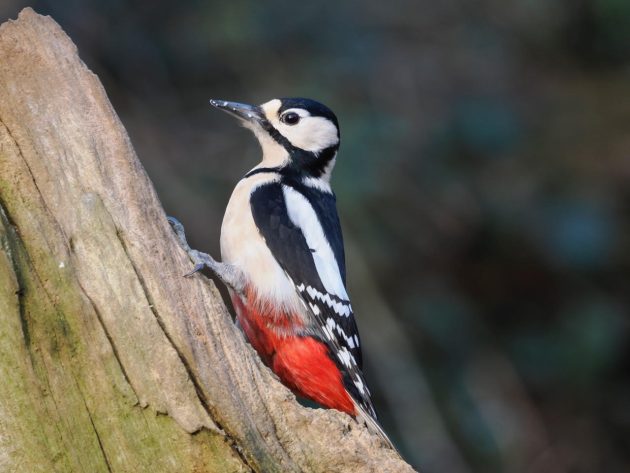
Of the world’s 256 species of woodpecker, the Great Spotted is arguably the most successful. Its range is vast and takes in three continents: Africa, Europe, and Asia. The African population is small, and is restricted to North Morocco, but it breeds throughout almost all of Europe (Iceland is the exception, but colonization of Ireland started two decades ago), and it can be found right across Asia as far east as China and Japan. It’s currently doing very well: in Britain, its population has increased by nearly 400% since 1967.
A handsome and easily recognised species, this is the black-and-white woodpecker you are most likely to encounter in Europe, where it is widespread and often common. In the UK it’s a familiar garden bird and one that is easily attracted to bird tables providing peanuts or suet, both favorite foods. It also occurs far from man in the taiga forests of northern Europe. These populations are semi-migratory, for when the pine crop fails, they will make invasive movements south, sometimes even reaching Britain. These northern birds are of the nominate race, major, and are recognizable by their clean white breasts, contrasting sharply with their black upper parts.
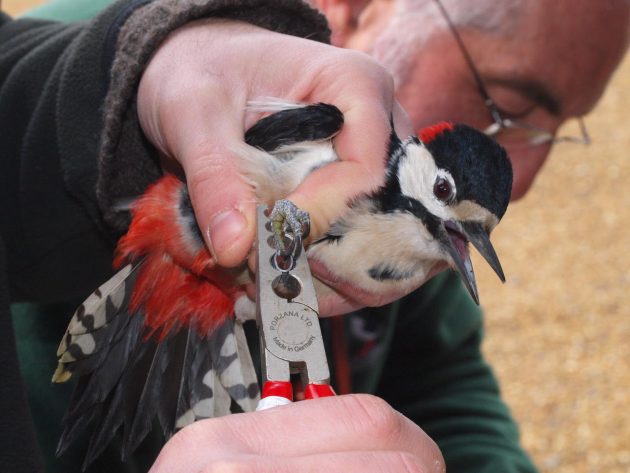
The range of the Great Spotted Woodpecker overlaps in eastern Europe with the very similar Syrian Woodpecker, and the two will sometimes interbreed. It can also be found nesting alongside all the other spotted woodpeckers, from the Middle-spotted to the Lesser. A major predator of eggs and nestlings, it’s thought that the decline of the Lesser in Britain may be partly due to predation by its bigger cousin (David Tomlinson).
White-backed Woodpecker (Dendrocopos leucotos)
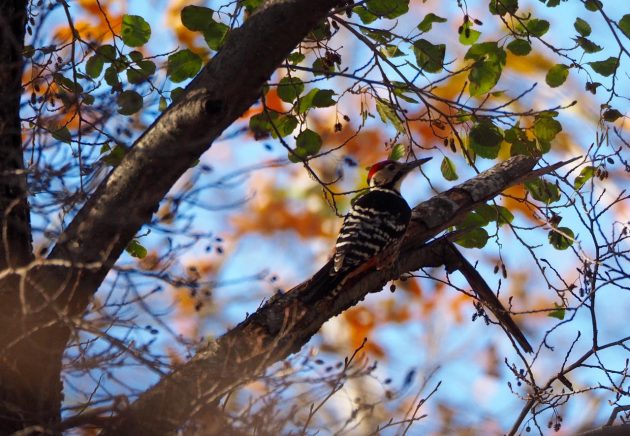
Europe’s rarest and most elusive woodpecker, the White-backed is another species with an extensive range, stretching across Asia all the way to Japan. This is a bird of old forests, thriving only in woodlands with a large amount of dead wood. It favors Europe’s remaining primeval forests, where the trees have never been harvested or managed.
Slightly larger than the Great Spotted, in Europe it’s only the nominate race leucotos that has a white back. Balkan birds, of the race lilfordi (shown in my photograph) have barred backs, and resemble large versions of the Lesser Spotted Woodpecker. Though elusive and often difficult to find, they are not shy birds, and can often be seen feeding low down, even at the bases of trees.
I found my first in Bavaria, the sighting a triumph as (along with Pygmy Owl, found on the same trip) this was a bird I was keen to see. I’ve subsequently seen birds in the French Pyrenees, where the isolated population numbers 300-400 pairs, Poland, Estonia, and Russia. On a trip to Lithuania, my guide was keen to show me these birds, but though we visited an occupied territory, with plenty of evidence of their recent presence, they remained frustratingly elusive. My encounters with lilfordi birds in the Balkans were both by chance and completely unexpected: one was in Bulgaria in May, the other in northern Greece in November (David Tomlinson).
Ground Woodpecker (Geocolaptes olivaceus)
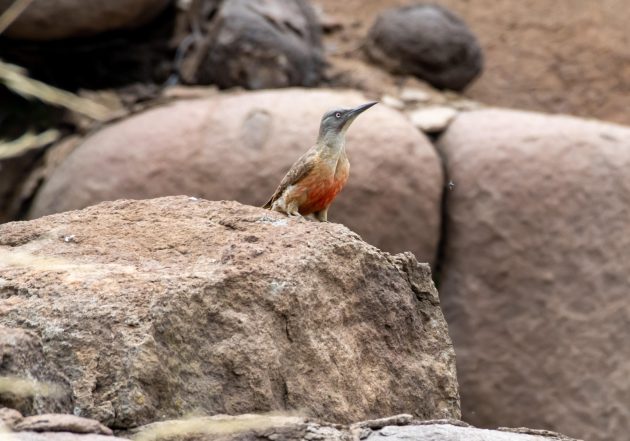
Found in the mountainous areas of South Africa, Lesotho, and Eswatini, the Ground Woodpecker (Geocolaptes olivaceus) is one of the few ground-dwelling woodpeckers in the world. It was on a barren landscape, amongst the boulders, that I first saw one not far from Sani Pass in Lesotho. It’s a stunning bird that Americans could easily liken to a Northern Flicker. They feed on all stages of the ant life cycle that are found in the wood or between rocks using their long, sticky tongue to extract. But will also flick through leaves on the ground looking for prey. The Ground Woodpeckers often forage in groups with a sentry on duty looking for predators, this position is swapped every 10 minutes or so (Hannah Buschert).
Lesser Spotted Woodpecker (Dryobates minor)
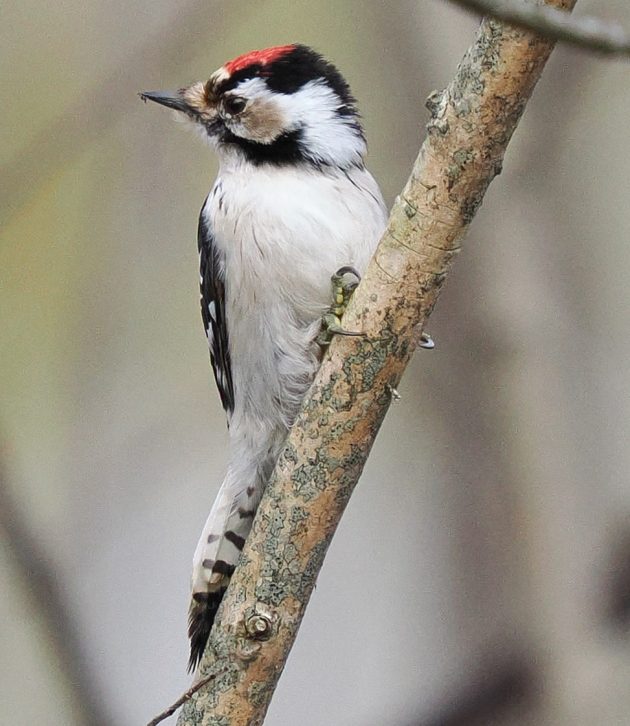
Every March I head off into my local woodland here in the southeast of England to play a game of “hide and seek” with Lesser Spotted Woodpeckers (Dryobates minor). For most of the year, these sparrow-sized birds live quiet lives amongst the leaves at the top of a woodland canopy. Early spring, however, when the males start to give their characteristic ki- k- ki call and there are no leaves to hide them, is the best season for the game. Lesser Spots are expert hiders, and finding them gets harder and harder each year, as the species is in serious decline here in the UK. Across the English Channel, they remain reasonably common, but sadly there are thought to be fewer than 1000 breeding pairs here.
Away from a nest, they are devils to spot. Active seeking is not usually the best strategy to employ as this tiny woodpecker can be hiding anywhere in a large wood. One must wait until the woodpecker decides to play fair by drumming or calling. Even then, spotting the bird remains a challenge and getting a photo is usually even harder. Despite this, it is a game that I relish, and I have been a successful seeker at least once in most years. This year, I was very pleased to hear a female in my local wood … but could I actually see it? No! Even better, I managed to find two on a recent birding trip to Georgia, but they both stubbornly stayed at the top of tall trees and were difficult to enjoy. Given the difficulties and current rarity of this delightful bird, I count myself very lucky to have found any at all (Martin Garwood).
Pileated Woodpecker (Dryocopus pileatus)
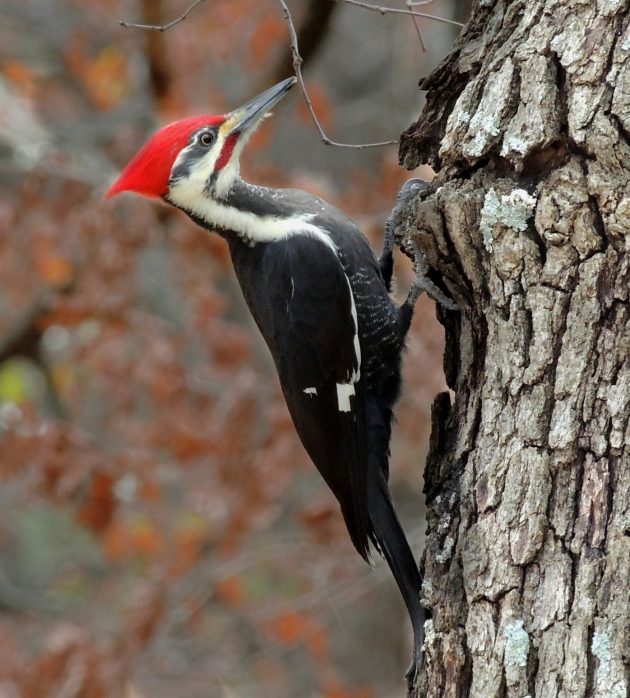
Photo by Josh Laymon used under Creative Commons License
There are a lot of things wrong with golf. It is obviously a very boring sport, but for us birders it’s the focus on the ball that’s the issue. Birders need to look up, not down. It can’t be a surprise that during the one round of golf I have played in my life I gave up at the fourth hole and started looking up. My silly colleague volunteered to slam my ball around the course for the rest of the morning, which made both him (the simpleton!) and me happy. However, my happiness skyrocketed for I encountered a Florida Moccasin Snake first and then a magnificent Pileated Woodpecker. It is, of course, smaller than the Black Woodpecker as Monsieur Buffon undoubtedly would agree, but it is massive, nevertheless. “Pileated” refers to its cap, not to “embarrassing problems in the nether regions caused by a lack of fibre in one’s diet”. The larger Ivory-billed Woodpecker has gone extinct, and this is such a loss that our American friends just can’t seem to accept this fact, so the IVBW still features in all field guides. For the more grounded among us (a.k.a. the cynics), the Pileated Woodpecker is still here to be enjoyed in all its splendour. It might just be worth a round of golf (Peter Penning).
Eurasian Wryneck (Jynx torquilla)

There are two wrynecks on this planet: the Eurasian Wryneck and the Red-throated Wryneck. The latter, an African species, can be seen relatively easily in Wakkerstroom, South Africa. Hire a community guide and head into the hills. The former used to be a Nemesis bird for me. A woodpecker that doesn’t peck wood, can mimic a snake, can turn its head 180o, and has a beautiful cryptically marked plumage. I would look at the pictures in the guidebook and head out to a place where it had been seen, only to return empty-handed. Everyone in an excursion group would see it fly by, except me. This went on for years, and I finally gave up. Wrynecks joined the ranks of the Pittas, non-existing AI-generated birds. Until one day. I was out on Cabo Espichel, a rocky cape south of Lisbon. It was early autumn, quite foggy and very quiet. The sun rose a bit higher and started burning off the fog. And just when it had cleared completely, a greyish bird flew past with the GISS of a woodpecker. It landed on top of a shrub and with my heart in my throat (could it be, at last?) I lifted my binoculars to my eyes … (Peter Penning).
Speckled Piculet (Picumnus innominatus)
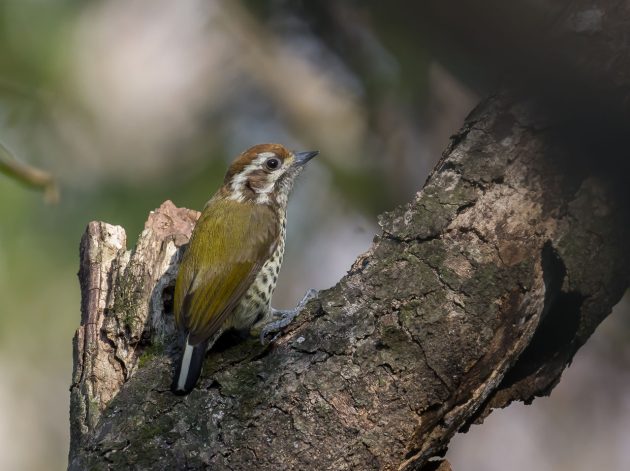
Like Peter, I have a faible for the weirdoes in the bird families. Unfortunately, Peter beat me to the wryneck, which certainly classifies as a weird woodpecker. However, there is another group of woodpeckers that is also quite distinctive – the piculets.
Piculets are small woodpeckers that lack the stiff tail feathers of true woodpeckers, so they are more likely to perch on branches than to climb trees (which true woodpeckers do with the help of their tail feathers). Also, their bills are shorter, so they mainly search for insects in decaying wood and reuse woodpecker holes for nesting rather than making their own holes (source).
Most of the 25 piculet species can be found in South America, but the Speckled Piculet is one of the three Asian ones and can be seen in my hometown Shanghai.
The scientific name is weird, too – innominatus means “unnamed”, giving rise to the paradoxon if an animal is still unnamed if its name is “unnamed”. Lacking the billions of parameters of large language models, I asked ChatGPT for an explanation for this. ChatGPT does not offer a definite answer but a few educated guesses:
“This paradoxical name likely reflects one of the following historical naming conventions or circumstances:
- A Placeholder Name That Stuck – The species may have initially lacked a distinct name when it was first described, and innominatus might have been used as a temporary designation, which was never changed.
- Lack of Distinctive Features – Some ornithologists in the past named species based on particularly striking traits. If a bird was perceived as lacking unique characteristics compared to its relatives, it might have been called innominatus as a way of indicating its nondescript nature.
- Taxonomic Uncertainty – The name could reflect initial uncertainty about its classification or relationships with other species when first described.
- Irony or Convention – Some taxonomists occasionally used innominatus ironically or traditionally when they couldn’t think of a more fitting name at the time of description.”
To me, option 1 seems the most likely, 2 and 3 rather unlikely (definitely no lack of distinctive features here), while given that the name was given to the species by a Brit, Edward Blyth, the fourth option cannot be ruled out completely.
A less exciting fact is that Piculet’s is a “complete solution to manage batch costing, production planning, scheduling, raw material costing and many more with SAP B1.” Though readers will be happy to learn that their “comprehensive and flexible solutions are pre-configured to meet the industry-specific needs of your business” (Kai Pflug).
Great Slaty Woodpecker (Mulleripicus pulverulentus)
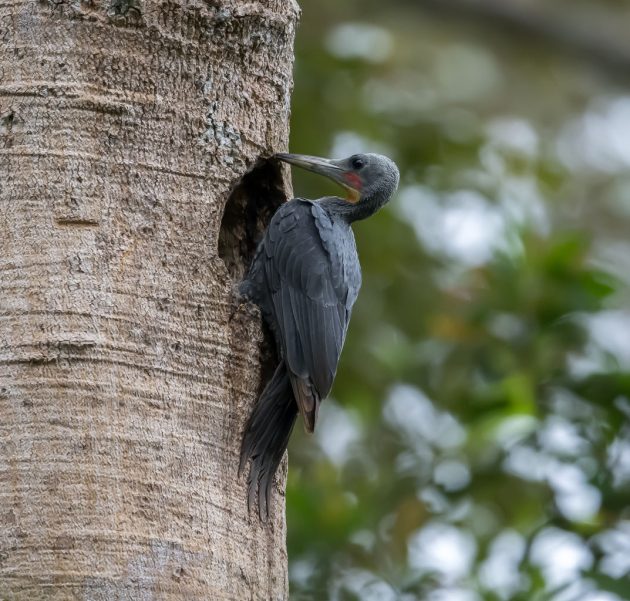
While the Pileated Woodpecker described above is big, it is not the biggest of the family – that is the Great Slaty Woodpecker, given that I share Peter’s cynicism about the Ivory-billed Woodpecker.
Even the typically subdued HBW seems to think that this woodpecker is something special: “Few birds are unmistakeable, but Great Slaty Woodpecker is close”.
Woodpeckers as a family are moderately endangered – more endangered than generalists, as many of them need older forests to survive, but less endangered than extreme specialists such as hornbills. The Great Slaty Woodpecker, however, is among the most endangered woodpeckers – it is listed as Vulnerable. Sadly, over the past century, at least 90% of the global population of the Great Slaty Woodpecker has been lost (source). See it before the Pileated Woodpecker becomes the largest woodpecker species alive (Kai Pflug).
Black-rumped Flameback (Dinopium benghalense)
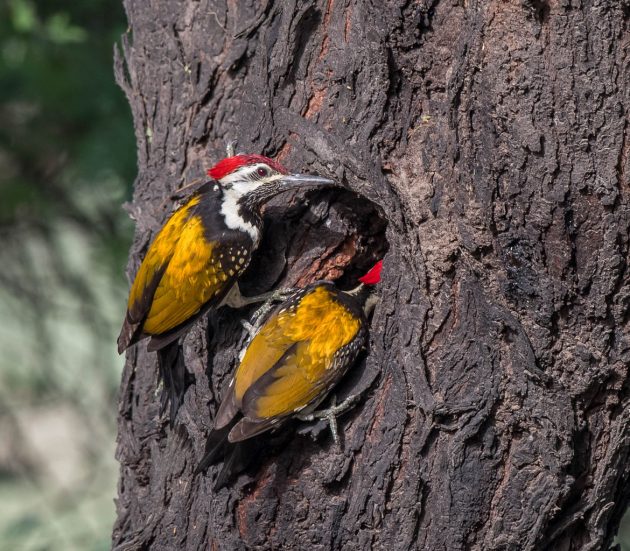
In the hit list of woodpeckers by continent, South America takes the lead with about 90 species, followed by Asia (more than 70), Africa (about 35), North America (22), and Europe (11), while Australia and (unsurprisingly) Antarctica do not have any. Unfortunately, none of our writers volunteered a South American entry, but at least the Black-rumped Flameback looks like a fairly typical Asian woodpecker species to me. Plus, I really like this photo. Somehow, it calls for some semi-funny subtitle along the lines of the female with its head inside the hole saying something critical to her spouse. If you can think of something, please put it in the comments (Kai Pflug).
Cover photo: Great Spotted Woodpecker




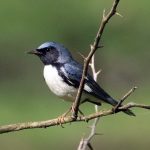
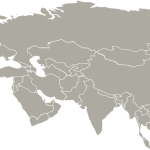


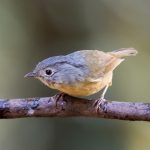

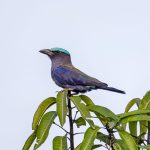
Entering a nomination for a runner up, the acorn woodpecker (Melanerpes formicivorus) who deserves some appreciation for having one of the more striking “crazy eyes” of the avian world ?
Enjoyed the article muchly. Agree with Laura and Brad above re the Acorn Woodpecker. It exhibits a fascinating and complex social structure. And for sheer beauty I love the Lewis’s Woodpecker found in the Western United States and a tad of Western Canada.
Ironically, I, Paul Lewis, raised in the western United States, have never seen the beautiful Lewis’s Woodpecker. I must do something about that.
Any guest post on the Acorn Woodpecker is very welcome!
Paul Lewis, you need to return to Bay Area, California. They can often be found behind Mt Hamilton.